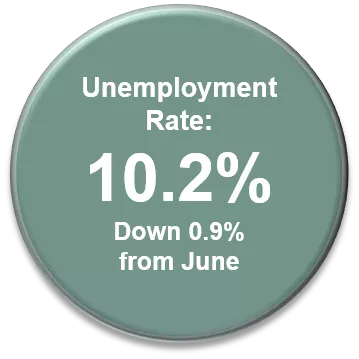August Economic Commentary: Momentum Slows as CARES Act Supports Expire

Chief Economist
Pohlad Companies
The fiscal response to the recession is running out of steam just as the rising virus case count has started to slow the pace of the recovery. The improvement in economic activity during May and June was largely the result of the unprecedented support provided to consumers and businesses through the CARES Act that was passed at the outset of the pandemic crisis in late March. The inability now for Congress to agree on the appropriate extension of benefits is creating uncertainty and will likely exacerbate the slowing economic momentum that became apparent in late July. The importance of continued fiscal support should be evident from the economic data discussed below.
Payrolls
The headline numbers of the Employment Report for July that was released on August 7 were better than expected. Non-farm payrolls increased by 1.8 million in July, but less than the increases of 4.8 million in June and 2.7 million in May. Many sectors posted job gains in July, but those increases broadly decelerated from the previous pace. Momentum in the labor market is slowing.

Unemployment
The unemployment rate fell to 10.2% from 11.1% in June. Unfortunately, it is expected that further gains will be harder to achieve. We are still above the 10.0% peak rate registered in 2009. The number of unemployed people declined by 1.4 million to 16.3 million, but that number is 10.6 million more unemployed than seen this past February. The employment/population ratio indicates the percentage of the working age population (age 15 -64) that is employed. This ratio improved slightly to 55.1% from 54.6% but remains near the lowest reading of this data series since 1948. February’s reading was 61.1%.
Continuing jobless claims did peak in early May and have been slowly coming down but are still running at about nine times pre-crisis levels. As mentioned last month, it was estimated that approximately 75% of workers claiming unemployment were making more because of the coronavirus unemployment bonus of $600 per week that expired July 31 than if they had remained employed. A thoughtful program is needed that does not encourage people to stay unemployed but assists them until they go back to work.
GDP
With the consumer accounting for 70% of GDP, high unemployment and low labor participation have a negative impact on overall income growth, and consequently overall GDP.
We also received the first estimate of second quarter GDP on July 30. The report said that 2Q-2020 Real GDP declined at an annualized rate of 32.9%, the worst quarter of economic growth on record. The Real GDP level is now back to where it was in 3Q-2014. The Fed estimates that it will take nearly three years for the economy to return to the levels seen at the beginning of 2020. Although a pickup in the second half of the year is expected, growth for the entire year is forecast to be around -6.0%—more than twice the 2.5% decline in 2009.
The GDP report only covers second-quarter data. More timely information can be monitored by watching the Weekly Economic Index published by the New York Fed that tracks 10 daily and weekly indicators of economic activity. This Index confirms slowing economic momentum starting in late July.
Long Recovery
In summary, it is very clear that while the economy appears to have bottomed in April, it is going to take a long time to recover from the deep economic hole that was created. Continued support from the government will be necessary. The pace of any economy recovery will depend on the consumer’s ability and willingness to spend. Thoughtful monetary and fiscal policies will need to remain as credible backstops for the consumer to be confident enough to support the recovery. Development of effective therapeutics or a vaccine remain critical to the restoration of confidence.
Insights
Research to help you make knowledgeable investment decisions